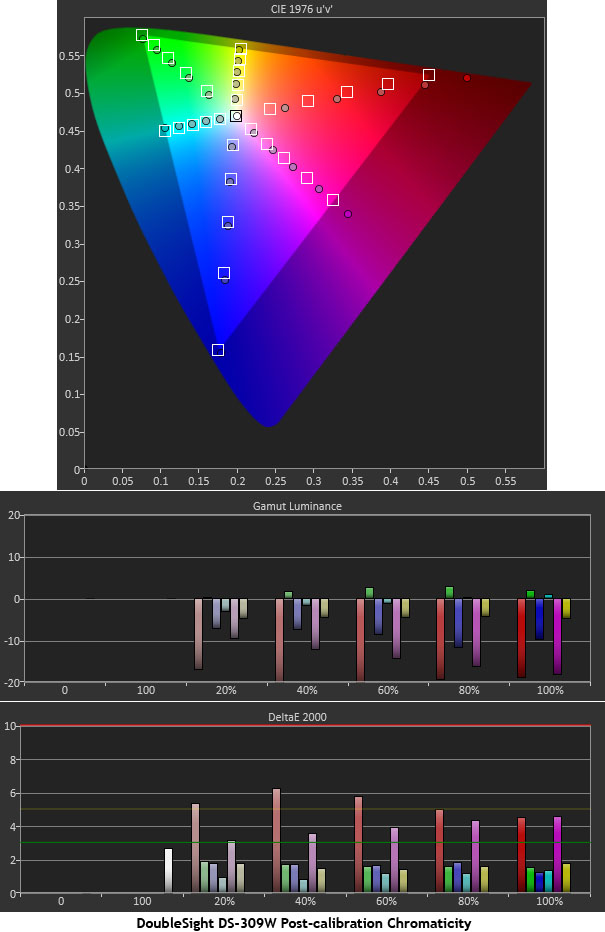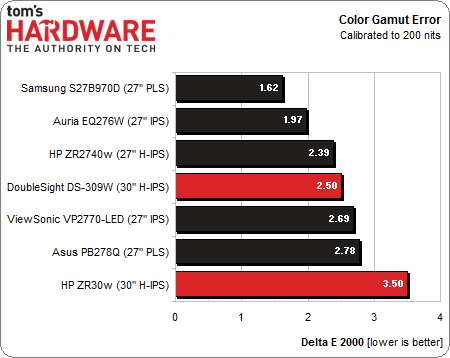HP ZR30w Versus DoubleSight DS-309W, 30-Inch Monitors, Tested
With a steady stream of 27-inch QHD monitors coming through our lab, we thought we’d take a quick break and test two even bigger screens, the 30-inch, 16:10 aspect ratio HP ZR30w and DoubleSight DS-309W. How do these $1000+ stunners compare?
Results: Color Gamut And Performance
Both panels in today’s review are wide-gamut monitors, designed to render 100 percent of the Adobe RGB 1998 color space. This means that more of the visible spectrum of color is displayed. If you look at the CIE charts below, you’ll see the fin-shaped area that represents all the color visible to the human eye. The triangle formed by the three primary colors is the gamut actually shown by the display. The Adobe RGB 1998 gamut extends the sRGB/Rec 709 spec by about 30 percent, mostly towards the green region of the chart. We adjusted our graphs to show both screens’ measurements relative to the larger color space.
Color gamut is measured using a saturation sweep that samples the six main colors (red, green, blue, cyan, magenta, and yellow) at five saturation levels (20, 40, 60, 80, and 100%). This provides a more realistic view of color accuracy. Since there are no color management controls on either monitor, we're only showing the post-calibration graphs (although we’re sure they'd look pretty much the same out-of-box).
HP ZR30w
The ZR30w tracks the larger gamut pretty well except for the red primary and magenta secondary colors, which are a little over-saturated. The rest of the color points are quite good with only tiny errors at all five saturation levels. This is excellent performance. Color luminance is a little hot for green, blue, and cyan, but very good for red, magenta, and yellow. We recommend creating a custom monitor profile for any screen intended for precise photo and graphics work. This way, small errors can be compensated for and matched to your camera and output devices.
Double Sight DS-309W
Overall performance is a little better on the DoubleSight. Like the HP, red and magenta are slightly oversaturated. Color luminance is low for red, blue, and magenta, but nearly perfect for the other colors. The DS-309W does squeak under the average Delta E three line with a value of 2.5. This is excellent performance.
Here is how both panels compare to other recently-tested monitors.
Get Tom's Hardware's best news and in-depth reviews, straight to your inbox.
None of the monitors in the group have any significant color accuracy issues. Even though the HP is on the bottom, its value of 3.5 is respectable. Remember that this is an average of 30 measurements. All of the screens offer professional-level color quality. The Samsung S27B970D continues to lead this benchmark, followed closely by the value champ, Auria's EQ276W.
Gamut Volume: Adobe RGB 1998
There are basically two categories of displays in use today: those that conform to the sRGB/Rec 709 standard like HDTVs, and wide-gamut panels that show as much as 100 percent of the Adobe RGB 1998 spec. We use Gamutvision to calculate the gamut volume, based on an ICC profile created from actual measurements.
The DS-309W displays a tick more of the Adobe RGB 1998 gamut than the ZR30w. The difference is negligible and not visible to the naked eye. The other screens are sRGB monitors and display the correct 68-72 percent gamut as they should. If you watch video or play games on either of the screens in today’s review, you will see that reds and greens look a little unnatural. It is important to match a display to its intended content. Unless you need the extra color saturation available on these panels, you may be dissatisfied with the color rendering of typical image content. We’d love to see selectable color gamuts on monitors like these. Any panel that renders Adobe RGB 1998 is capable of rendering sRGB. Many consumer TVs have this feature, so there’s no reason to omit it on a computer monitor.
Current page: Results: Color Gamut And Performance
Prev Page Results: Grayscale Tracking Next Page Results: Viewing Angle And Uniformity
Christian Eberle is a Contributing Editor for Tom's Hardware US. He's a veteran reviewer of A/V equipment, specializing in monitors. Christian began his obsession with tech when he built his first PC in 1991, a 286 running DOS 3.0 at a blazing 12MHz. In 2006, he undertook training from the Imaging Science Foundation in video calibration and testing and thus started a passion for precise imaging that persists to this day. He is also a professional musician with a degree from the New England Conservatory as a classical bassoonist which he used to good effect as a performer with the West Point Army Band from 1987 to 2013. He enjoys watching movies and listening to high-end audio in his custom-built home theater and can be seen riding trails near his home on a race-ready ICE VTX recumbent trike. Christian enjoys the endless summer in Florida where he lives with his wife and Chihuahua and plays with orchestras around the state.
-
vmem "And for those who demand a density above 100 pixels per inch and a tall 16:10 aspect ratio, they represent the top of the heap...for now"Reply
Isn't the ASUS PQ321 already out along with a few other 4K monitors? granted price is a whole other story -
Marcus52 The lack of an OSD makes the ZR30w a much better gaming monitor, as the OSD causes higher lag. Personally I have no problem doing without one.Reply
You seriously can't see the pixels? I can see them on a 27" 2560x1440, which has smaller pixels. The .25mm range is adequate to me, but really I'd prefer something smaller than the .233mm on the 2560x1440. -
x2ruff4u You guys should wait to get any IPS screen. 60HZ is all they come in & tbh 60HZ in terms of technology is old. I would wait to get a 120HZ IPS monitor because it REALLY makes a difference. Sure you can OC your monitor, but most only go up to 90HZ and that can put a toll on it and eventually fry it. Your best bet is to get a 120hz-240hz TV and if your worried about MS don't be. Compared a low MS to a higher HZ there is very little difference in tech terms (read up about it) This year or beginning of next year WE should be getting some nice monitors you can be proud you spent your money. Hell ASUS already has a 4K monitor and I bet money on 4K monitors by mid-end next year.Reply -
Onus Troll post(s) deleted.Reply
When considering something like this for games, don't forget the cost of the video card(s) needed to drive it. A HD7750 may be "sufferable" even up to 1920x1080, but I'm not sure even a HD7770 or GTX650Ti could play newer games on better than "low" settings on one of these.
-
kungpaoshizi How the heck did you get those numbers via the input pcb for input lag?Reply
I have a ZR30W myself, and I would NEVER trade it unless what I'm upgrading to has more than a 2560x1600 resolution.
I've played on all sorts of monitors, and resolution trumps all other specs, unless you're dealing with 30fps or something...
I really wish I would have spent 1200$ on it long ago. Battlefield 3 and other highly graphical games are comparable to nothing else in the world. -
kungpaoshizi Oh btw, I run BF3 high/ultra settings with a GTX 570 oc'd, and it's peachy enough I don't tell my g/f I'm taking my other 570 out of the machine she's using to hook up SLI again...Reply
The 60hz is not "old tech", it's more than sufficient to run games smoothly if vertical sync is on (even still when it's off). 60 fps is fine, television (pre hd) was 28hz. Anything above 60fps you really don't notice too much.
Oh, and for those looking for 4k tv's to use (I'm way ahead of ya) they only have 30hz refresh rates over the HDMI 1.2 port. We're going to have to wait for the tv's to add another port, wait for the upgrade to HDMI 2.0, or wait for some other solution. -
hero1 I can safely say that I will sit tight and wait for the 4K monitors to hit the market at a reasonable price and grab one as long as they come in at 60Hz or 120Hz and not 30Hz.Reply -
RedJaron It's a shame manufacturers treat 16:10 ratio as a rarity. A decent 1080p is often a little cheaper than a smaller 1680x1050 display and half as much as a slightly larger 1920x1200. Personally I can't stand a 16:9 for a computer. It's fine for TVs and watching media, but to work on I have to have that extra height.Reply -
hero1 Reply11058091 said:It's a shame manufacturers treat 16:10 ratio as a rarity. A decent 1080p is often a little cheaper than a smaller 1680x1050 display and half as much as a slightly larger 1920x1200. Personally I can't stand a 16:9 for a computer. It's fine for TVs and watching media, but to work on I have to have that extra height.
We aren't going to see many 16:10 in the future. the 4K stuff is going to be 16:9 unless someone makes the move to stick with 16:10. However, the difference when it comes to 16:9 with a 2560x1440 and 16:10 2560x1600 is very minimal unless you really really need that extra height!



